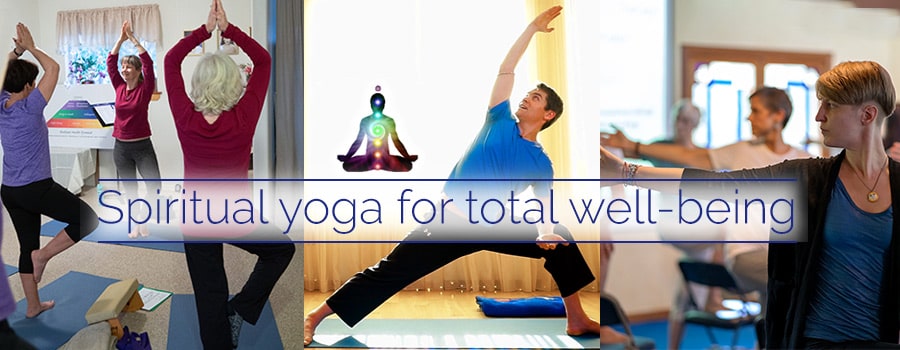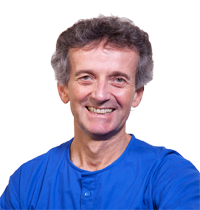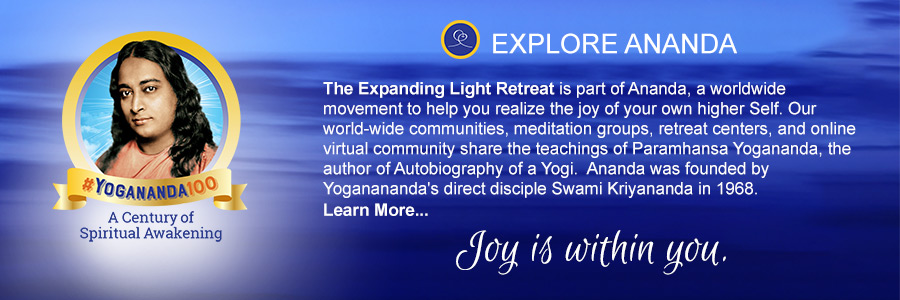|
This article was written for the Ananda Yoga® Teacher Association newsletter. Learn more, or find a certified Ananda Yoga® teacher near you. |
Forward and Backward Bends
Questions and Answers
Question #1: Is it physically safe to round the lumbar spine in a forward bend?
Just for fun, I surveyed a number of experienced yoga teachers, physical therapists, chiropractors and an osteopath. Their responses agreed with what we’ve been teaching, i.e., it’s okay to round the spine in the surrender phase, provided:
- The spine is healthy to begin with. Injured spines (discs, nerves, etc.) need special care.
- There is no discomfort. (Discomfort usually suggests a problem.)
- Rounding comes as a result of relaxation, not of straining to go farther into the bend. Straining can put excessive pressure on the anterior portions of the discs.
- The practitioner maintains a constant, conscious awareness of what is happening with the spine. Without that awareness, the spine is vulnerable.
In fact, some of these experts emphasized that it’s unwise never to round the spine; just like any other muscles in the body, the back muscles need to be stretched to stay healthy!
I’ve known plenty of students — and teachers — who habitually strain in a forward bend. (Some of them have back problems now, by the way.) It’s the “don’t wimp out” approach that’s so popular in Hatha Yoga today.
Some teachers actually sit on a student’s back in paschimotanasana, trying to force a deeper bend. Of course we want to go deeper into the pose over time, but it’s risky to push on vertebrae; stay with pressing forward and up on a student’s sacrum to help roll the pelvis forward.
Question #2: Which should come first: forward bends or backward bends? Or are they all mixed together?
Earlier this year, my wife Diksha and I had an amusing experience with this question in our two-week intensive at Ananda’s Yoga and Meditation Retreat in Assisi, Italy.
One student — who assured the class that she’s been to many ashrams in India — insisted that all the forward bends should be completed before doing any backward bends.
On the next day another student, after assuring the class that she had received in-depth training in numerous Hatha styles, insisted that all the backward bends should come before any forward bends. Ah, the joy of conflicting yoga traditions!
In The Art and Science of Raja Yoga, Swami Kriyananda explains the Ananda Yoga® approach: “One should follow a bend in one direction with a bend in the opposite direction, so as always to return the body to a state of balance, even as the teaching of yoga is that one must neutralize the opposites of duality, and become identified with the one central Reality, the Adwaitic, or non-dual Spirit which rests forever at the eye of the storm of creation.”
This “balance” is energetic as well as physical. All creation is comprised of pairs of opposites: light/dark, up/down, in/out, hot/ cold, female/male, young/old, etc. — and of course, forward/ backward.
Each of us has an innate awareness that these opposites represent a movement away from center, and our very nature cries out for that “eye of the storm” — and for the symmetry of movement that helps us find it.
Thus in Ananda Yoga® we don’t do all the bends in one direction, then all the bends in the opposite direction. Rather, we generally follow a bend in one direction with a bend in the opposite direction, which naturally draws our awareness to what lies between: the spine. That is balance.
But don’t just assume you — or your students — are in balance after a complementary bend. Ask yourself, “Have I really found balance?” If not, then do a pose that will help you return to the neutral state, to the spine.
In some cases, that might even mean doing, say, two backward bends in a row after a forward bend (or vice versa). That’s fine; it’s the experience of balance that’s important, not strict equality between the number of forward bends and the number of backward bends.
To put it another way: it’s not a matter of what it should take to find your center; it’s a matter of what it does take.
Question #3: Should we first do a backward bend, then a forward bending counterpose, or vice versa?
In his book, Ananda Yoga for Higher Awareness, Swami Kriyananda gives the rule of thumb that one should do a forward bend first, followed by a backward bend. Here is the exact quote:
“Forward-stretching poses should always be followed by others that stretch backward. … It would seem, at least from our experience, that the forward-stretching poses open the nerve channels in the spine, but that the backward-stretching ones help to pour energy through those opened channels.”
In The Art and Science of Raja Yoga, however, Swami Kriyananda merely said, “Follow a bend in one direction with a bend in the opposite direction.” Not quite so specific. So I asked him for a clarification.
Here is his reply:
“Normally, follow a forward bend with a backward bend. In cases, however, where it seems appropriate, the opposite sequence is fine.”
(Nice to have room for creativity, isn’t it?)
It may seem natural to do a backward bend first, because those tend to cry out for — physically speaking — counterposes more than do most forward bends. For example, after an intense backward bend like Ustrasana, the body needs a forward bend; an easy one, like Balasana, can feel just right.
You may even want to follow that with sasamgasana as well, not for back relief but because Sasamgasana helps us take charge of all the energy that’s been awakened by Ustrasana, then released by Balasana. All that is fine, but what Swami is saying is that, generally in Ananda Yoga, we start the whole sequence with a forward bend — Adho Mukha Shvanasana (before Ustrasana) might be a good choice in this case.
There are additional reasons for starting with a forward bend. We all know how Matsyasana, a backward bend, is a perfect follow-up for Halasana, a forward bend. It’s not just for physical reasons, although the physical release of the cervical spine is certainly welcome. Rather, it’s that Halasana can concentrate a lot of energy in the cervical center (fifth chakra); Matsyasana enables us to open up that area and get that energy moving and expanding.
Here’s another example: Swami teaches that Padahastasana and Standing Bbackward Bend (SBB) are a natural sequence: First you open the spine with Padahastasana so energy will flow freely, then you lift that energy up the spine with SBB.
Although the opposite order is by no means “wrong” — it can feel good even if you haven’t gone swayback in SBB — note that SBB is a thoracic spine asana, whereas Padahastasana is a lower spine (sacral area) asana. Therefore reversing the order simply wouldn’t be as effective in raising the energy because Padahastasana would be working below the area where SBB had already worked.
This is a specific example of the general principle that forward bends tend to work with the first and second chakras. Backward bends tend to work higher in the spine, especially in the third and fourth chakras. (There are exceptions, but this is the general nature of those types of poses.) Again, since we are trying to raise energy up the spine with our practice, it makes sense to work with the lower chakras first.
By the way, have you noticed that some of the sample routines in The Art and Science of Raja Yoga end with two backward bends. Try it. It’s a great way to take maximum awakened energy straight into meditation. (Kriyabans: note that you’ll soon get a complementary forward bend anyway, via Maha Mudra.)
Looking from the other direction, why might one sometime want to do a backward bend first? Well, if your energy has been a scattered, you might use a backward bend to awaken your awareness of the energy and get it moving, then a forward bend to calm and focus it.
Or if you need a boost, you might do a backward bend to awaken energy, then just enough of a forward bend to give a physical release without dissipating the energy. (If we don’t have enough energy to stay focused, forward bends can be sleep-inducing rather than calming.)
By the way, forward bends aren’t the only possible complementary poses after backward bends; a twist can be a good, too. I may use a twist to make sure I don’t lose the energy awakened by the backward bend, because for me they maintain the energizing effect of the backward bend better than do forward bends.
Or, if I want to be sure that I don’t relax so much in a forward bend that I allow the energy to dissipate, I may hold it only for a short time (e.g., a brief knees-to-chest release after Setu Bandhasana).
Remember too, that different poses offer different degrees of bend in different locations. There are gentle bends (e.g., Balasana, Matsyasana) and intense bends (e.g., Halasana, Chakrasana). Some backward bends focus on the cervical region (e.g., Matsyasana), others on the thoracic (SBB), still others on the lumbar (Salabhasana).
Likewise, forward bends may focus on the cervical spine (Karnapirasana), thoracic spine (Janushirasana), or lumbar spine (Sasamgasana, which also bends the thoracic). All these poses are quite different, so they require individualized consideration.
Stay Flexible
All this points to the need for personal understanding of principles rather than blind following of rules. That’s why the practice of yoga is really rather simple. It’s when we try to memorize everything — rather than understand — that complications arise.
For example, you’ve been through a chakras routine — sequencing postures according to the chakras that they help magnetize — and felt the power that it can bring. It’s a wonderful practice, and it makes a lot of sense to design routines that way: using the asanas to work your way up the spine, chakra by chakra, ending at the spiritual eye, even if you never even think of the word, “chakra.”
But that isn’t a hard and fast rule, even with chakra routines. If it were, then we’d never do Paschimotanasana (first and second chakras) after having done the standing backward bend (fourth chakra) earlier in our routine. Rather, feel what needs to happen — and do it. Different objectives call for different treatment.
It’s the joyful art of practicing and teaching Ananda Yoga.
All authors are graduates of Ananda Yoga Teacher Training.





















